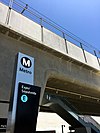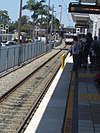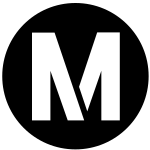List of Los Angeles Metro Rail stations
 From Wikipedia - Reading time: 15 min
From Wikipedia - Reading time: 15 min

The Los Angeles Metro Rail is an urban rail transit system in Los Angeles County, California, operated by the Los Angeles County Metropolitan Transportation Authority (LACMTA or Metro). The system includes 102 metro stations with two rapid transit (known locally as a subway) and four light rail lines, covering 109 miles (175 km) of route service.[1] In 2019, the Metro Rail system served an average 295,889 passengers each weekday, totaling 93.2 million passengers in the calendar year.[2] Metro Rail is one of the largest rapid transit and light rail systems in the United States by ridership.[3] The system is complemented by two Metro Busway bus rapid transit lines.
History
[edit]Metro Rail began service on July 14, 1990, when the light rail Blue Line opened between Pico and Anaheim stations;[4] the line was extended to Downtown Long Beach and Pacific Avenue stations on September 1.[5] The Blue Line was extended one stop northward from Pico to 7th Street/Metro Center on February 15, 1991.[6] The next Metro Rail line, the rapid transit Red Line, opened on January 30, 1993, between Union Station and Westlake/MacArthur Park station.[7] The light rail Green Line, the system's third line, opened on August 12, 1995, from Norwalk to Redondo Beach stations.[8] Metro Rail's next expansion occurred on May 22, 1996, when the Red Line expanded westward from Westlake/MacArthur Park to Wilshire/Western stations.[9] The Red Line expanded again on June 12, 1999, with a branch from Wilshire/Vermont to Hollywood/Vine stations.[10] The final section of the Red Line opened on June 24, 2000, from Hollywood/Vine station to North Hollywood station, completing the Red Line as originally planned.[11] A fourth Metro Rail line, the light rail Gold Line, opened on July 27, 2003, between Union Station and Sierra Madre Villa station in Pasadena.[12] The rapid transit Purple Line became the fifth Metro Rail line on August 24, 2006, when LACMTA separated the Red Line into two separate services; the branch between Union Station and Wilshire/Western station became the Purple Line while the branch between Union Station and North Hollywood station remained the Red Line.[13] The Gold Line was later extended to Atlantic station in East Los Angeles on November 15, 2009.[14] The light rail Expo Line opened between 7th Street/Metro Center and La Cienega/Jefferson on April 28, 2012; two additional stations opened on June 20, 2012.[15] The Gold Line's second extension opened on March 5, 2016, and added six more stations from Sierra Madre Villa from to APU/Citrus College.[16] An extension to the Expo Line on May 20, 2016, added seven stations.[17] The opening of the K Line on October 7, 2022, added six stations.[18] The Regional Connector project featured two new underground stations as well as a rebuilt Little Tokyo/Arts District station. Aviation/Century station opened on November 3, 2024.[19]
System
[edit]The system has 102 stations serving its six lines. Thirteen of these stations are transfer stations, which allow passengers to transfer between lines. Eleven of these stations are termini—stations at the end of lines. 54 of the stations are within the city of Los Angeles and the other 48 stations are located in surrounding communities in Los Angeles County.
Lines
[edit]There are six Metro Rail lines, each of which is associated with a letter.
| Name | Stations | Termini | Opening | Newest extension | Length[20][21][1] | Ridership (weekday)[2] |
Type | Former line name(s) |
|---|---|---|---|---|---|---|---|---|
| 44 | APU/Citrus College (north) Downtown Long Beach (south) |
1990[22] | 2023[23] | 48.5 miles (78.1 km) | 69,216 | Light rail | ||
| 14 | North Hollywood (north) Union Station (south) |
1993[22] | 2000[22] | 14.7 miles (23.7 km) | 64,729[A] | Rapid transit | ||
| 11 | Aviation/Century (west) Norwalk (east) |
1995[22] | 2024[19] | 19.3 miles (31.1 km) | 21,902 | Light rail | ||
| 8 | Wilshire/Western (west) Union Station (east) |
1993[22][B] | 1996[22][C] | 5.1 miles (8.2 km) | 64,729[A] | Rapid transit | ||
| 29 | Downtown Santa Monica (west) Atlantic (east) |
2012[22][D] | 2023[23] | 22 miles (35 km) | 48,913 | Light rail | ||
| 12 | Expo/Crenshaw Aviation/Century (north) Westchester/Veterans Redondo Beach (south) |
2022[25] | 2024[19] | 5.9 miles (9.5 km) | 3,136 | Light rail | — |
List of stations
[edit]For stations served by more than one line, lines are listed in the order of opening.
| * | Transfer stations |
| ** | Termini |
| † | Transfer stations and termini |
Future stations
[edit]| Station | Image | Line(s) (Project name) |
Location[26] | Opening | Ref(s). |
|---|---|---|---|---|---|
| Century City/Constellation | 
|
(Westside Extension) |
Los Angeles (Century City) | 2026 | [40] |
| Glendora | 
|
(Foothill Extension) |
Glendora | 2025 | [41] |
| La Verne/Fairplex | 
|
(Foothill Extension) |
La Verne | 2025 | [41] |
| LAX/Metro Transit Center† | 
|
Los Angeles (Westchester) | 2025 | [42] | |
| Pomona North** | 
|
(Foothill Extension) |
Pomona | 2025 | [41] |
| San Dimas | 
|
(Foothill Extension) |
San Dimas | 2025 | [41] |
| Westwood/UCLA | 
|
(Westside Extension) |
Los Angeles (Westwood) | 2027 | [43] |
| Westwood/VA Hospital** | 
|
(Westside Extension) |
Los Angeles (Westwood) | 2027 | [43] |
| Wilshire/Fairfax | 
|
(Westside Extension) |
Los Angeles (Beverly Grove / Carthay / Mid-Wilshire) | 2025 | [43] |
| Wilshire/La Brea | 
|
(Westside Extension) |
Los Angeles (Hancock Park / Mid-Wilshire) | 2025 | [43] |
| Wilshire/La Cienega | 
|
(Westside Extension) |
Beverly Hills | 2025 | [43] |
| Wilshire/Rodeo | 
|
(Westside Extension) |
Beverly Hills | 2026 | [40] |
Notes
[edit]- ^ a b Ridership data is combined for both the B and D lines.
- ^ Opened as the Red Line, became the Purple Line in 2006.
- ^ Originally the Wilshire Branch of the Red Line.
- ^ The oldest segment of the E Line opened in 2009 as part of the Gold Line.[24]
- ^ Little Tokyo/Arts District station originally operated as an at-grade station from 2009 to 2020.
- ^ Union Station began operating as a Metro Rail station on January 30, 1993, but it had been continuously operating as an inter-city and commuter rail station since May 5, 1939.[39]
References
[edit]- ^ a b "Facts At A Glance". Los Angeles County Metropolitan Transportation Authority. June 2023. Archived from the original on March 19, 2023. Retrieved June 22, 2023.
- ^ a b "Metro Ridership (for May 2024)". Los Angeles Metro. Archived from the original on April 10, 2021. Retrieved May 3, 2023.
- ^ "Transit Ridership Report, First Quarter 2011" (PDF). American Public Transportation Association. 2011-05-31. Archived from the original (PDF) on 2011-07-09. Retrieved 2011-09-18.
- ^ West, Karen (July 15, 1990). "Festive Air Marks Debut of Blue Line". Los Angeles Daily News.
- ^ Gallego, Julie (September 2, 1990). "L.B. Whoops it Up at New Loop As Trains Swing Into Downtown". Press-Telegram.
- ^ McGreevy, Patrick (February 15, 1991). "Metro Rail's First Subway Station Opens". Los Angeles Daily News.
- ^ Katches, Mark (January 31, 1993). "Red Line Rolls to Raves – It's Smooth Railing As L.A. Subway Opens". Los Angeles Daily News.
- ^ Mariani-Belding, Jeanne (August 13, 1995). "All Aboard! Metro Green Line Makes 1st Run – Thousands Try Norwalk-to-Redondo Beach Train". Los Angeles Daily News.
- ^ Bloom, David (May 22, 1996). "MTA Unveils New Downtown Line". Los Angeles Daily News.
- ^ Hiestand, Jesse (June 13, 1999). "Hollywood Subway Picks Up Rave Reviews". Los Angeles Daily News.
- ^ Sheppard, Harrison (June 18, 2000). "End of the Line". Los Angeles Daily News.
- ^ Bender, Mary (July 27, 2003). "Golden Opportunity - Riders Board L.A.-Pasadena Line". Los Angeles Daily News.
- ^ "Color Designations" (PDF). LACMTA. August 24, 2006. Archived (PDF) from the original on September 26, 2011. Retrieved September 18, 2011.
- ^ Bloomekatz, Ari B. and Hector Becerra (November 16, 2009). "After decades of waiting, their trains have arrived". Los Angeles Times. Archived from the original on November 8, 2012. Retrieved September 18, 2011.
- ^ Turner, Dan (March 23, 2012). "Expo Line to fill an L.A. gap". Los Angeles Times. Archived from the original on April 22, 2012. Retrieved April 23, 2012.
- ^ Nelson, Laura J. (March 5, 2016). "San Gabriel commuters cheer as Gold Line rail extension officially opens". Los Angeles Times. Archived from the original on November 2, 2020. Retrieved March 5, 2016.
- ^ a b c d e f g h Nelson, Laura J. (February 25, 2016). "Metro Expo Line to begin service to Santa Monica on May 20". Los Angeles Times. Archived from the original on March 2, 2016. Retrieved May 20, 2016.
- ^ "New $2.1bn Metro K Line opens in Los Angeles, California". Railway Technology. October 10, 2022. Archived from the original on 22 June 2023. Retrieved 22 June 2023.
- ^ a b c d Hymon, Steve (October 14, 2024). "Changes are coming Sunday, Nov. 3, to the C and K Lines as we open the new Aviation/Century Station". Metro The Source. Retrieved October 16, 2024.
- ^ "Regional Connector Transit Corridor Project Contract No. E0119 – Operations and Maintenance Plan (Final)" (PDF). Los Angeles Metro. September 10, 2013. p. 2-1. Archived (PDF) from the original on May 2, 2019. Retrieved May 23, 2018.
- ^ "LA Metro celebrates opening of HNTB-designed K Line". HNTB. October 10, 2022. Archived from the original on January 8, 2023. Retrieved January 8, 2023.
- ^ a b c d e f g "Facts at a Glance". Los Angeles County Metropolitan Transit Authority. November 18, 2013. Archived from the original on August 20, 2019. Retrieved November 16, 2013.
- ^ a b Von Quednow, Cindy (June 16, 2023). "Metro Regional Connector opens in Los Angeles, bringing more direct access to downtown". KTLA. Nexstar Media Group. Retrieved June 16, 2023.
- ^ "Projects and Plans - Metro Gold Line Eastside Extension". Los Angeles County Metropolitan Transportation Authority. Archived from the original on August 28, 2004. Retrieved April 14, 2024.
- ^ Hymon, Steve (2022-09-22). "The K Line opens Friday, October 7!". The Source. Retrieved 2023-11-28.
- ^ a b "Mapping L.A.: Neighborhoods". Los Angeles Times. Archived from the original on May 12, 2019. Retrieved December 10, 2015.
- ^ "Maps". Downtown Los Angeles Center Business Improvement District. Archived from the original on December 6, 2015. Retrieved December 10, 2015.
- ^ "Metro Rail Timeline". Los Angeles Metro. Archived from the original on December 22, 2015. Retrieved December 10, 2015.
- ^ "FY2024 Ridership by Station". misken67 via Los Angeles Metro Public Records. August 2024.
- ^ a b c d e f g h i j k l m n o p q r s t u v "Metro A Line (Blue)". Los Angeles Metro. Archived from the original on August 10, 2020. Retrieved September 14, 2020.
- ^ a b c d e f g h i j k l m n "Metro B Line (Red)". Los Angeles Metro. Archived from the original on October 26, 2020. Retrieved September 14, 2020.
- ^ a b c d e f g h "Metro D Line (Purple)". Los Angeles Metro. Archived from the original on July 24, 2020. Retrieved September 14, 2020.
- ^ a b c d e f g h i j k l "Metro E Line (Expo)". Los Angeles Metro. Archived from the original on September 20, 2020. Retrieved September 14, 2020.
- ^ a b c d e f g h i j k l m n o p q r s t "Metro L Line (Gold)". Los Angeles Metro. Archived from the original on September 22, 2020. Retrieved September 14, 2020.
- ^ a b c d e f "Gold Line Foothill Extension". Los Angeles Metro. Archived from the original on February 14, 2024. Retrieved September 14, 2020.
- ^ a b c d e f g h i j k l m n "Metro C Line (Green)". Los Angeles Metro. Retrieved December 10, 2015.
- ^ a b c d e f Hymon, Steve (September 22, 2022). "The K Line opens Friday, October 7!". Los Angeles Metro. Archived from the original on March 23, 2023. Retrieved September 28, 2020.
- ^ a b c Von Quednow, Cindy (June 16, 2023). "Metro Regional Connector opens in Los Angeles, bringing more direct access to downtown". KTLA. Nexstar Media Group. Archived from the original on August 12, 2023. Retrieved June 16, 2023.
- ^ Harnisch, Larry (May 5, 2009). "Union Station Opens, May 5, 1939". Los Angeles Times. Archived from the original on October 29, 2020. Retrieved September 14, 2020.
- ^ a b "D Line Subway Extension Project – Section 2". Metro. Retrieved July 9, 2024.
- ^ a b c d "Background". Foothill Gold Line. Retrieved April 14, 2024.
- ^ "🚨 Two big changes are coming soon to the C and K Lines Nov. 3". Instagram. Los Angeles County Metropolitan Transportation Authority. Retrieved October 22, 2024.
- ^ a b c d e "D Line Subway Extension Project – Section 1". Metro. Retrieved July 9, 2024.
External links
[edit]
 KSF
KSF





































































































